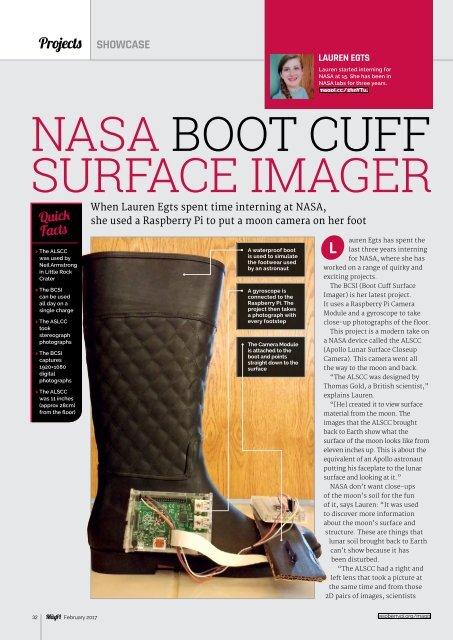-ORIENTED
MagPi54
MagPi54
You also want an ePaper? Increase the reach of your titles
YUMPU automatically turns print PDFs into web optimized ePapers that Google loves.
Projects<br />
SHOWCASE<br />
LAUREN EGTS<br />
Lauren started interning for<br />
NASA at 15. She has been in<br />
NASA labs for three years.<br />
magpi.cc/2hnYTuJ<br />
NASA BOOT CUFF<br />
SURFACE IMAGER<br />
Quick<br />
Facts<br />
> The ALSCC<br />
was used by<br />
Neil Armstrong<br />
in Little Rock<br />
Crater<br />
> The BCSI<br />
can be used<br />
all day on a<br />
single charge<br />
> The ASLCC<br />
took<br />
stereograph<br />
photographs<br />
> The BCSI<br />
captures<br />
1920×1080<br />
digital<br />
photographs<br />
> The ALSCC<br />
was 11 inches<br />
(approx 28cm)<br />
from the oor<br />
When Lauren Egts spent time interning at NASA,<br />
she used a Raspberry Pi to put a moon camera on her foot<br />
A waterproof boot<br />
is used to simulate<br />
the footwear used<br />
by an astronaut<br />
A gyroscope is<br />
connected to the<br />
Raspberry Pi. The<br />
project then takes<br />
a photograph with<br />
every footstep<br />
The Camera Module<br />
is attached to the<br />
boot and points<br />
straight down to the<br />
surface<br />
L<br />
auren Egts has spent the<br />
last three years interning<br />
for NASA, where she has<br />
worked on a range of quirky and<br />
exciting projects.<br />
he oot u ure<br />
Imager) is her latest project.<br />
It uses a Raspberry Pi Camera<br />
Module and a gyroscope to take<br />
oeup photogrph o the oor.<br />
This project is a modern take on<br />
a NASA device called the ALSCC<br />
(Apollo Lunar Surface Closeup<br />
Camera). This camera went all<br />
the way to the moon and back.<br />
“The ALSCC was designed by<br />
Thomas Gold, a British scientist,”<br />
explains Lauren.<br />
“[He] created it to view surface<br />
material from the moon. The<br />
images that the ALSCC brought<br />
back to Earth show what the<br />
surface of the moon looks like from<br />
eleven inches up. This is about the<br />
equivalent of an Apollo astronaut<br />
putting his faceplate to the lunar<br />
surface and looking at it.”<br />
NASA don’t want close-ups<br />
of the moon’s soil for the fun<br />
of it, says Lauren: “It was used<br />
to discover more information<br />
about the moon’s surface and<br />
structure. These are things that<br />
lunar soil brought back to Earth<br />
can’t show because it has<br />
been disturbed.<br />
“The ALSCC had a right and<br />
left lens that took a picture at<br />
the same time and from those<br />
2D pairs of images, scientists<br />
32 February 2017<br />
raspberrypi.org/magpi


